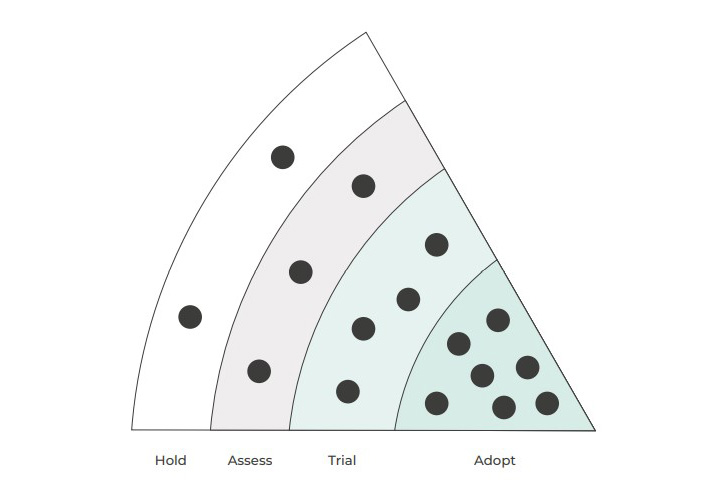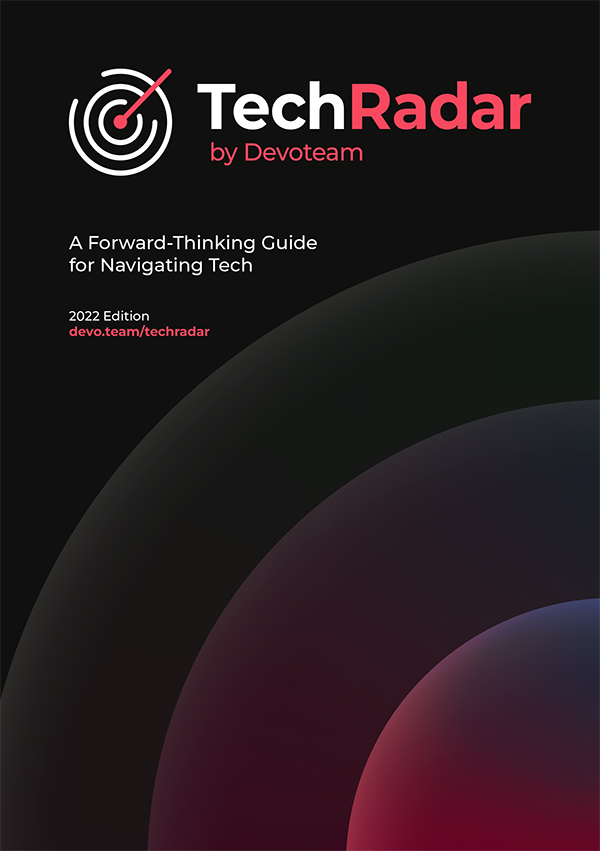Devoteam TechRadar is all about tracking interesting technologies whether they are emerging or already proven in the market. They have been carefully selected by our experts to help you navigate digital complexity and classified using 2 different elements: strategic domains and rings. The strategic domains represent topics that we consider as strategic for organisations’ to become leading digital companies. The ring indicates our analysis of the technology readiness as of today – from the more “mature” ring and business-ready – Adopt – to the less one – Hold – which means the technology is a little too new to merit full investment, but should be kept in mind for future problem solving nonetheless.

- Hold: Proceed with caution. We recommend waiting to see how the technology develops further.
- Assess: Worth investigating to understand how it might affect your organisation.
- Trial: Worth pursuing. You might want to try this technology on a beta project to understand how to develop this capability at scale.
- Adopt: We strongly believe that this technology should be adopted by the industry. We use it whenever appropriate in our projects.
Themes for this Edition
Decentralisation
Increasingly decentralised and granular approaches to complexity.
The cloud is more than a technology. It is first and foremost a way of approaching problems – decentralised, differentiated, agile, innovative – that has become a necessity for understanding the complexity of the world. This explains its unanimous and overwhelming success. Centralised approaches, hierarchical processes and “one size fits all” solutions can no longer assimilate such colossal quantities of information and provide each business, each employee and each customer with the rapid, personalised and efficient responses they expect. Increasingly combining on-premise and cloud systems under a single control plane, decentralisation is becoming the rule. Problems are being addressed in ever finer detail and solutions are being built using ever smaller building blocks, microservices, containers and functions, by increasingly autonomous teams. The technology landscape reflects this evolution, for which Gartner uses the term ‘composite’. As we can see throughout this technology radar, innovation is largely focused on these elementary blocks available and executed in the cloud; on the tools that allow them to be implemented, orchestrated, secured, scaled and the costs of this added complexity to be limited; and on the means of bringing solutions closer to the ground, by involving the business more in the development process.
The challenge today is to industrialise decentralisation and decentralise industrialisation.
- Simplicity
Ease of use, a double-edged obsession.
To enable everyone to exploit the latest technologies and focus as much as possible on business issues (and, incidentally, to alleviate the shortage of IT skills), the vast majority of technologies listed in these pages have in common that they seek to make things easier. They create layers of abstraction to hide the underlying infrastructure, they offer connectors and standard functionalities, they automate tedious tasks, they use artificial intelligence, they offer graphical interfaces and code-free tools… Kubernetes is emblematic of this trend, and is so complex yet so essential that a whole ecosystem of solutions is being created around it to make it more accessible to developers. However, ease is not simplicity, and even less rigour. Without governance, without the strict application of common rules and without, in spite of everything, a certain technical expertise, simplicity is only a façade. The proliferation of technological artefacts created with illusory ease creates hidden complexities that will have to be unravelled one day. To quote the great Dutch mathematician and computer scientist Edsger Dijkstra:
Simplicity is a beautiful quality, but it cannot be achieved without hard work, nor can it be appreciated without education. And to make matters worse, complexity sells better.”
- Speed
In a world of speed, technology sets the pace
A mong the three requirements of cost/quality/time that govern any business project, time seems to have become paramount. If the solution arrives too late, the costs will never be met anyway. As for quality, there is no longer any question of sacrificing it, as we can now do things quickly and well through agile iterations. As a result, speed is the common denominator for the technologies in this paper, whether it is accelerating IT projects themselves, decision making (through analytics and artificial intelligence), or operations (through automation). The technology world itself is caught up in this hype, and this paper is unequivocal evidence of that. It now takes only two years for a technology to mature, five years to become a standard, and ten years to become outdated. This astonishing acceleration is due in particular to the rise of open source, which is now everywhere. Subjected at birth by their creators to the appetite of developers for innovation and their critical sense, the most promising technologies spread and are perfected very quickly, accumulating users in laboratories, universities and start-ups before gradually reaching traditional companies. Better still, because of its model, open source makes it possible to go fast while reducing costs and improving quality.

It now takes only two years for a technology to mature, five years to become a standard, and ten years to become outdated.
- Sustainability
A still emerging concern for sustainable development
A technology affects all aspects of life, it is natural that all aspects of life should in turn affect technology. Technology can no longer ignore the major issues of today: the environment, resilience, ethics, inequality, etc. It is no longer enough that it does not contribute to the aggravation of these issues. Tech is now expected to help address them seriously and provide solutions. When it comes to reducing greenhouse gases, large cloud based platforms are leading the way because of their scale and because their size gives them enormous leverage within clean energy use. According to IDC, switching to the cloud, and therefore to a highly energy-efficient infrastructure, often powered by renewable electricity, would make it possible to avoid the emission of one billion tonnes of CO2. Behind the leading cloud providers however, few other platforms have started to tackle this concern. Not many of these other platforms have eco-designed solutions that are intrinsically low on resources, that strive to combat accelerated hardware obsolescence, and that make their low environmental footprint an element of differentiation. However, we expect it is only a matter of time until they tackle this concern. Sustainability, which has already been taken up by the major players, will undoubtedly be one of the defining trends in technology in the months and years to come.

According to IDC, switching to the cloud, and therefore to a highly energy-efficient infrastructure, often powered by renewable electricity, would make it possible to avoid the emission of one billion tonnes of CO2.
